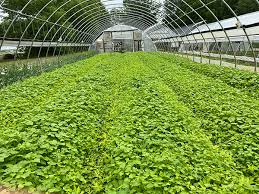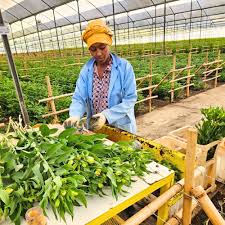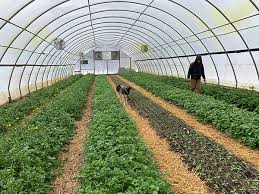Flower cultivation plays a significant role in enhancing the hill environment and strengthening the rural economy. Its relevance in agricultural systems can be highlighted through the following contributions:
i. Generation of cash income sources for rural communities
ii. Creation of employment opportunities in both pre-harvest and post-harvest operations
iii. Fulfilment of aesthetic needs of the population
iv. Promotion of a sustainable and permanent agricultural system in hilly areas
Despite these advantages, flower cultivation is often overlooked by farmers and horticulturists on a commercial scale due to the perishable nature of flowers. At the end of this article, the following key points are expected to be understood.
Read Also: Mushroom Growing Kits
Principles and Practices of Out-of-Door and Greenhouse Flower Crop Production

1. Greenhouse Flower Crop Cultivation: Production Classifications
Greenhouse flower crop production is generally categorized into three types:
i. Grower: Specializes in production and sells through wholesalers or retailers.
ii.Grower-wholesaler: Produces select crops and also purchases from other growers to offer a full range to retailers, often including floral supplies.
iii. Grower-retailer: Produces a wide variety of flowers and sells directly to consumers, eliminating intermediaries for better profitability.
2. Key Principles of Greenhouse Flower Cultivation
- Greenhouses are enclosed with transparent materials such as plastic, polycarbonate sheets, glass, or FRP.
- These coverings transmit most of the sunlight into the structure.
- The plants, floor, and other internal surfaces absorb sunlight and emit long-wave radiation, which is retained inside, raising the internal temperature a phenomenon known as the greenhouse effect.
Advantages of Greenhouse Flower Crop Production
1. Enables year-round production of flowers regardless of location
2. Produces blemish-free, high-quality flowers
3. Allows for effective pest and disease control
4. Reduces water usage
5. Lowers labour requirements
6. Promotes early flowering and shortens production cycles
Basic Agricultural Considerations for Greenhouse Flower Cultivation

- Feasibility study to assess viability
- Selection of appropriate greenhouse structure
- Choice of planting material suited to market and climate
- Adoption of effective growing systems
- Implementation of plant protection measures
- Efficient post-harvest handling methods
- Support facilities for assessing water and media quality
- Proper management and coordination of operations
General Cultural Guidelines in Cut Flower Production
1. Root Media Management
Soil-based media are preferred as most flowers are cultivated in ground beds. A good root medium must provide drainage, aeration, and water retention.
Common amendments include sphagnum peat moss, vermiculite, and perlite. Pasteurization through steaming is recommended between crops. Soil tests should guide amendments before planting. Optimal pH for most flower crops ranges between 6.0 – 6.5.
2. Watering and Fertilisation Practices
Avoiding foliar wetting is essential to prevent diseases like Botrytis. Ooze tubes and perimeter irrigation systems are effective.
Nutrient application is best done with a constant-feed system using injectors. Recommended nutrient levels are 200–250 ppm of nitrogen and potassium.
Ammonium nitrogen is avoided in winter due to slow conversion and potential toxicity. Superphosphate and micronutrients should be incorporated as part of the root medium mix.
3. Light Intensity Requirements
Full light intensity encourages high-quality flower production. However, in high-light seasons like summer, shading is necessary to avoid petal burn. Shading can be achieved through:
- Application of shading compound on greenhouse glazing
- Installation of shading curtains
- Use of saran nets over growing beds
Shading to 50% intensity is often sufficient for optimal photosynthesis and growth.
4. Support Systems for Tall Flowering Crops
As many cut flower crops grow tall, structural support is essential for straight stem development. Common methods involve using welded wire fabric grids (8 x 8 inches) placed over the crop. These are installed in multiple layers, spaced 12–18 inches apart, to support the plants as they grow upward.
5. Harvesting Techniques in Cut-Flower Production
Harvest timing varies by crop:
- Flowers like roses are harvested at the start of opening.
- Snapdragons are harvested with few florets open.
- Carnations and chrysanthemums are harvested when buds show color suitable for long-distance shipping.
After cutting, lower leaves are removed to prevent decay. Stems are recut under water and placed in warm floral preservative to maintain water uptake. Storage temperature is maintained at 35–40°F until sale.
Read Also: Mushroom farming at home
Post-Harvest Handling of Cut Flowers in Agriculture

After harvesting, cut flowers are graded by stem length, strength, flower size, and number of blooms. Bunching is done by dozens or groups of 25, then sleeved for protection.
Floral preservatives mixed in holding water enhance vase life and maintain flower quality. These include food sources and ethylene inhibitors critical since ethylene causes petal drop and delays in bud opening.
Crops like carnations and freesia are particularly sensitive to ethylene.
Floriculture is rapidly becoming a profitable venture within the agricultural sector. Its steady growth across the globe indicates its importance, especially in developing countries, as a reliable component of modern agriculture.
Greenhouse flower cultivation operates on essential principles involving transparent covers to trap sunlight and create a favorable environment for flower growth.
The article outlines classifications of growers, cultivation methods, watering, fertilisation, lighting, support, harvesting, and post-harvest practices serving as a foundation for successful cut-flower production in agricultural systems.
Do you have any questions, suggestions, or contributions? If so, please feel free to use the comment box below to share your thoughts. We also encourage you to kindly share this information with others who might benefit from it. Since we can’t reach everyone at once, we truly appreciate your help in spreading the word. Thank you so much for your support and for sharing!

